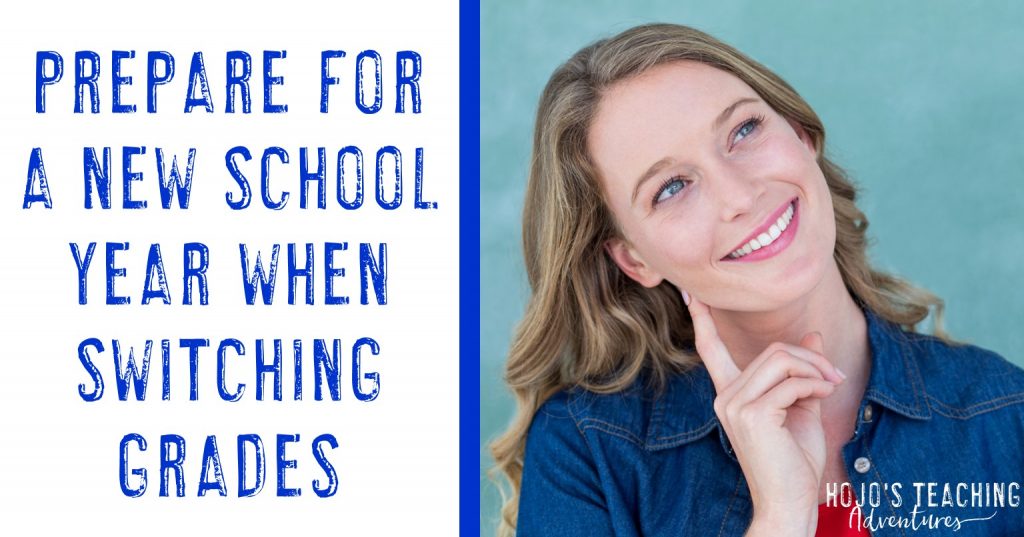While there are many people out there who have taught the same grade for many years, or sometimes even decades – I am not that person. After seven years in the classroom I taught seven different things. Then during my eighth year I did yet another different thing by becoming an administrator. That’s why today I want to share with you how to prepare for a new school year when you are switching grades.
There are many things to consider when you are switching grades. What will my classroom management look like? How do I implement technology at this grade level? Do I have the correct resources to teach this grade effectively? And what type of parent communication is expected with this age group?
The questions above and many more are quite typical when you are switching grade levels.
But let’s back up for just a moment. Exactly what did I teach when I say I switched grade levels each year?
Year 1 – 3rd & 4th grade combo teacher and K-8 special education overseer at a Hutterite Colony school (100% Lower Income & ELL)
Year 2 – 2nd/3rd/4th grade combo teacher and K-8 special education overseer at a Hutterite Colony school (100% Low Income & ELL) *2nd grade was only present in the morning, they went to another teacher in the afternoon
Year 3 – Reading Recovery teacher and 1st/2nd/3rd grade Title I Reading & Math (80% Low Income school)
Year 4 – Kindergarten classroom teacher (80% Low Income school)
Year 5 – 5th Grade Special Education Inclusion Teacher (30% Low Income school; high homelessness rate)
Year 6 – 6th Grade Elementary Classroom Teacher (affluent community)
Year 7 – 4th/5th/6th Grade Reading/Writing Teacher (affluent community)
Year 8 – K-6 Elementary Principal of two schools and K-12 District Special Education Director (affluent community)
As you can see above – I did something pretty different each year. While years one and two may look very similar, they really weren’t. Since I taught a combo class, my grammar, phonics, science, and social studies curriculum were entirely different. Reading and math were the same each year, but that was it. Every other year has been something totally new.
Don’t get me wrong – I’m not complaining in the least! I love teaching new things. It keeps me on my toes, prevents me from getting bored, and has given me a LOT of great teaching experience. 🙂
However, all of these changes have made me realize a few things you should know about how to prepare for a new school year when you are switching grades.
1. Find a classroom management system that works!
I’ve known principals that think a teacher who can’t handle upper elementary students may do better with lower elementary. However, in my experience – a teacher with great classroom management will be great regardless of grade level. Come up with a few simple rules like these – 2-5 usually do the trick. Explicitly teach them, and then hold high expectations all year long. It also doesn’t hurt to talk to other teachers at the grade level you’re moving to in order to get some fresh ideas. Each school and group of students will be different, but yet the key things will be the same.
2. Seek out new resources to make life easier.
That first year with a new grade level, new resources, and new expectations is tough. In a way, you’re a first year teacher all over again. I never really got the chance to “repeat” curriculum. Yes, I sometimes taught 1-4 subjects a second year in a row, but I had a lot of new items on my plate each year. Thankfully Teachers Pay Teachers has been an amazing resource for me!
You’re going to spend hours in your new grade level figuring out routines and how things work. If there are some morning work ideas or games that will make teaching a bit easier, ask your school for some purchase order money or invest in these resources. You and your sanity will both be glad you did!
3. Read up about your new position.
Whether you’re going to be teaching Kindergarten for the first time or moving into an administrative position, start reading up about what to expect. You may want to grab a few professional reads, start surfing Pinterest and the multitude of blogs online, or go to at least one summer workshop to help you get prepared. While this can seem overwhelming, you’re going to appreciate having new ideas and information in front of you to work with. Of course meeting for coffee, lunch, or drinks with others who are currently teaching the grade level you’re moving to won’t hurt anything either. 😉
4. Think about room layout and decor.
If you’re only going up or down one grade level, you may not need to give your classroom layout much thought. But when you’re used to teaching 4th grade Hutterite students and then your next classroom teaching assignment is for Kindergarten students, you just might find yourself walking around the classroom on your knees the day before the students arrive making sure things are at the appropriate eye level for them because you hadn’t given it a single thought until a coworker walked in and made a comment. #guilty
It’s also important to think about what type of classroom decor you want. Are you the type of person who wants everything matching and perfect when students walk in, or will you let your students take ownership of the room by helping you add the materials? There really is no right or wrong here, but it’s something to think about – particularly as you change grade levels or assignments.
5. Ask for a trial.
If the chance is given to you to have a “trial run” of your new assignment – take it! When I went from Reading Recovery to Kindergarten, the principal allowed me to shadow the current teacher for a few days. When she had to be gone, they had me sub in her room. It gave me a much better idea of what to expect that fall. Yes, I had a Kindergarten endorsement from college – but nothing in my experience had prepared me like those few extra days did.
6. Get organized.
Do your best to get organized the year/summer before you change grade levels. Purge or put anything you can’t use into storage. Dig out, make, or buy resources for the upcoming year. You can’t plan ahead for everything, but think about your favorite themes, units, and activities for the year. Look at your curriculum and start doing some mapping – even if it’s only in your head. Thinking about these types of things ahead of time may be a bit overwhelming, but it’s going to help you out a great deal as the school year goes on.
7. Expect the unexpected.
No matter how much you read, analyze, plan, and prepare – be ready for something to go wrong in those first days, or even in that first year. I’m a planner. So the first day I taught Kindergarten I planned enough activities to last 1.5 days. However, by lunch, I had used them all. EEK! That afternoon, we went through my next two days in lesson plans. Needless to say, I was at the school very late that night trying to really get the next day’s plans down.
No matter how prepared you are, something will go wrong. Murphy’s law, anyone? Try not to let it stress you out too much. Things happen. Do your best, and now that your students still have an awesome, caring teacher who is doing his or her best. 🙂
~~~~~~~~~~~~~~~~~
- Helpful Hints & Tips for New Teachers
- FREE Bright School Year Printable Tag (for students OR staff!)
- Stomp Out Inappropriate Language at the Beginning of the Year
- School Rules: How to Start the Year Off Right
- Stopping Behaviors Before They Start
- “That’s Easy!” – The Impact of Such a Simple Phrase
- Gathering Student Information FREEBIE
- Creating Tolerance in the Classroom



Thank you for the TIPS! I am bummed that the links are not working, as I would like to read further.
I am sorry they weren’t working. I just went through and updated them all, so you (and others!) will be able to continue reading and learning from my ideas. =) ~Heather aka HoJo~